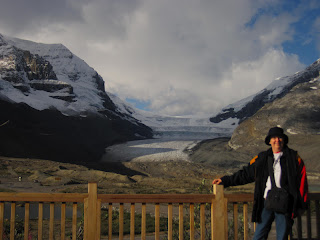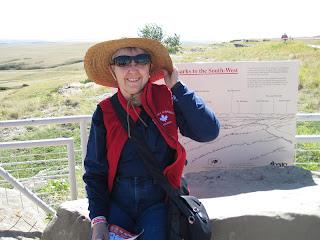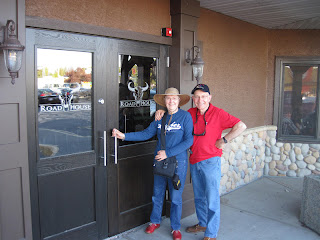For Nancy and I, vacations are adventures where we seek to experience new places and meet new people. We've never had a vacation where we relaxed.
We figure we can relax at home.
We can sleep when we're dead.
We are both serious about learning about the nature of new places, and yet we are also both shameless tourist, eager to buy a trinket or tee shirt that will reflect the places we've been. (Nancy makes quilts from the tee shirts, but this is a subject for another blog.)
What makes a great vacation even greater is when we meet guides who love what they do and project their enthusiasm to travelers; when we meet fellow-travelers who politely take turns posing at a perfect picture site or ask if they can take our picture with our camera for us; and when we encounter restaurant servers and workers of all kinds who smile while doing their jobs serving the public, who take time to chat, and who make an effort to make a traveler feel welcome.
Let me give you a few examples from our recent trip to the Canadian Rockies.
We started planning our vacation rather late, and getting a reservation near Lake Louise, Alberta, Canada, was a challenge. After a few frustrating attempts to make a reservation on the Internet and a couple phone calls to places that did not fit our needs, we called Mountaineer Lodge. A lady by the name of Kat answered the phone and her spirited and friendly banter lifted our spirits as she quickly took the reservation. We stayed there two nights and it was perfect for us.
A short walk from the Mountaineer Lodge is the Lake Louise Station Restaurant, which is train depot converted into a fine dining restaurant. Yes, it is spendy, but the staff and food and atmosphere provide a special experience that you won't want to miss. Our waiter was James, and he provided great service and agreed to have his picture taken, as well as take our photo.
James took us outdoors to snap our photo (above),
and posed for a photo (below).
James is a waiter who enjoys his work and passes that enjoyment onto his customers.
The next morning we left early to get to the Columbia Ice Fields where we had tickets for the bus which would take us to the Athabascar Glacier. We've seen glaciers before, but this was a chance to actually walk around on one.
Here's Nanc posing in front of the Athabascar Glacier, which is the tongue of ice in the center of the photo. The Columbian Ice Fields stretch above and behind the glacier and cannot be seen in this picture. The glacier is over 7009 yards wide and over 3800 yards long, ending near the center of the photo where ice no longer exists.
We arrived before the rush and the efficient staff got us on the first bus out, which loaded at 9:30 AM, and took us on about a ten-minute ride to the where we would board the specially-made, buses that drive on the glacier. On the short ride to the glacier, the driver and guide introduced themselves, and the guide began explaining the mountains and glaciers surrounding pour trek. These two men seemed to love what they do, while they made the short trip interesting and fun.
The driver, Roy, gave big smile as Nancy snapped his photo. We didn't get a photo of the guide.
We debarked the bus at a station a short distance from the glacier, and climbed aboard buses especially made to drive on the glacier.
These buses were especially designed for use on glaciers. They are manufactured near Banff, Canada, and 22 of the 23 in existence are used by this company giving tours around the Banff area and the Athabascar Glacier. Another is in use in Antarctica.
This bus took us down a 32% grade for about a 100 yards to a small man-made pool, which the driver slowly drove through to clean mud off the tires so they would not bring dirt onto the glacier.
Bruce, our driver, was very knowledgeable and clearly loved his job. He told stories and explained facts about glaciers during the ten-minute drive to the turn-around area near the middle of the glacier.
Before we get off the bus, Bruce explains the dangers of cervices in glaciers and reminds us to only walk on the safe area, which had been graded and checked for safety earlier in the morning.
The photo of me by the bus gives you an idea of the size of the tires.
Bruce carefully checks out the glacier (above), while Nancy and I (below) have a fellow-traveler take our photo standing in the safe zone with the top of the glacier behind us.
Bruce plants the flag and takes our photo by it (above),
and then Nanc takes a photo of Bruce by the flag (below).
The temperature was cold but pleasant on the glacier and we hated to leave, but we knew our 20 minutes was almost up when we saw another bus approach the turn-around area. Soon after, we loaded ourselves onto the bus and began the trip back.
Bruce continued to enthusiastically explain more about glaciers.
For example, why are glaciers bluish?
It starts with the fact that all snow begins by moisture gathering and freezing on natural particles of dirt in the atmosphere. Snow that is not under pressure contains more oxygen, and since oxygen reflects all the colors of light, regular snow appears white.
However, glaciers are snow that has been under a great deal of pressure, which has squeezed out the oxygen and the particles of dirt reflect the spectrum of blue light.
In the center of the photo above, you can see the bluish tint of the snow near the bottom of the packed ice. Bruce explained that the reason more blue did not show up other places is because fresh snow had fallen during the night. The fresh snow is not packed and is, therefore, white, but as the sun melted the new snow, the bluish color of the packed snow and ice showed through.
Next question: why is glacial water bluish?
Before the ice melts, the pressure and movement of the glacier grinds the dirt particles into a fine powder called glacial flour, which colors the water bluish as can be seen in glacial runoff and glacial lakes. Once we changed buses and headed down the mountainside for the brief ride back, our driver and guide, Caroline, who had a beautiful French accent, pointed out two streams running down the mountain. One stream had bluish water, which came from the glacial melt. The other stream had clear water that came from a nearby spring. Sorry we couldn't get photo of the contrasting streams, but don't take my word for it, visit the Columbia Ice Fields to check it out for your self.
A day later we drove south through western Alberta, eager to visit the Head-Smashed-In Buffalo Jump near Ft. Macleod, Alberta. A Buffalo jump is a site where Native Americans, called First Nations in Canada, have herded buffalo over a drop off to kill them for food. Head-Smashed-In was used from 5500 years ago to the mid-1800s and gets its name from a young brave who stood under the cliff watching as many buffalo were riven over the edge. For him it was much like standing under a waterfall as water flowed over in front of him like water, but as the buffalo piled up, he found he could not escape. He was later found with his head smashed in.
One the way to the jump, we stopped at the Claresholm Museum and Visitors' Center where we met Bob, who was so enthusiastic about his job of helping people find exciting things to do in the area that we came out of the place with all sorts of maps and books and facts. The museum itself offers a treasure of antiques clearly displayed and described, but it was Bob's personal attention to the visitors that made the place an excellent stop.
The Head-Smashed-In Buffalo Jump Interpretive Center is built into the hillside with the entrance on the lower level on the bottom of the photo. The building rises up six stories to the top of the cliff where visitors can walk out upon the very trail the buffaloes followed before they plunged to their deaths.
When we entered the building, we were greeted by Leandra, a smiling guide with a fun sense of humor, who we visited after the tour as she shared stories with us. The place is lucky to have her. She quickly explained to us that we should start the tour by going up to level six and walking on the top of the cliff.
Nancy holds onto her hat. The wind on the cliff top was powerful and loud. It blew over a three-year-old child as she tried to stand on a rock. No damage done to the child, but we thought it inappropriate to snap a photo of the kid's attempts. The wind was a loud as a freight train and prevented most conversation. Most visitors left rather quickly, but it was an experience we will remember.
After viewing the museum's artifacts on all six floors, we exited to walk along the base of the cliff and found that the area where the buffaloes died was now overgrown with chokecherry bushes, a fitting destiny for the land, since chokecherries were one of the berries First Nations used to mix with dried buffalo meat to make pemmican, which they ate during winter months.
We used the timer to snap a photo of the two of us by the sign as we left.
We drop on to Lethbridge to stay the night. Next to our motel was Mr. Mike's Steakhouse Casual, where we encountered Kyla, a friendly bartender who shared stories about her grandparents who came to Alberta. Kyla clearly liked her job and made our evening a fun event.
We took her photo (above), and she took our photo (below).
The next day we drove south across the boarder, east across Montana on Highway #2, and stayed at a hotel at Williston, ND.
Some of the temporary housing near Williston, ND.
Williston is experiencing an oil boom, and temporary housing lined the highways as we drove into town. Road construction was all around, struggling to keep up with the influx of cars and people. Once we found our hotel, we didn't want to move the car so we walked a short distance to a family restaurant, which was clearly understaffed. I give credit to the hard-working cooks and servers who hustled to keep up with customer orders. On the way out I noticed a sign above a pile of forms. The sign said, "If you have a complaint, please take one." The form was an application to work at the restaurant.
Early the next morning we drove to the North branch of Theodore Roosevelt National Park. This was our third attempt to visit the place over a period of ten years. Each time roadwork in the park prevented our visit. This time, the friendly ranger told us about half of it was open so we could drive into the park about six miles. He said that the soil in the park made very poor roadbeds and roads had to be repaired often. He was very helpful and interesting. He showed us a 15-minute film that reminded me of the important role the Civilian Conservation Corps (CCC), a program created by Teddy's cousin, President Franklin Delano Roosevelt, played in developing many parks into places the whole family could enjoy. TR was a leader in designating park and monument lands, and he deserves total credit for starting a conservation movement that led to our modern park system. However, without the expenditures for roads, trails, and buildings built by the CCC, the parks would not have been accessible to most of us for the past 80 years or so.
We stopped at Medora and drove on to Fargo to stay overnight at a Wyndham Hotel. During check-in the ladies at the desk welcomed us with free hors d'oeuvres and drinks. After a day of driving and touring, nothing was more welcome. Great timing!
Later, we walked across the parking lot to the Space Aliens Bar and Grill (above), where we were welcomed and served by Lyndsey and her friend from behind the bar, Paul (below).
Lyndsey generously spent time chatting with us and helped make our evening enjoyable.
This was our final overnight stay on our travels. The next morning we left fort Buffalo River State Park in Minnesota, where we walked on paths for a coupe hours and visited with the friendly, knowledgeable rangers.
During the drive south to our home near Lakeville, we discussed our trip. It was eight days since we had crossed the border into Canada and entered Saskatchewan for the first time. We loved viewing the wheat fields as far as we could see, and we never tired of witnessing farmers scramble to get their harvest done.
After driving about 10 hours to Strathmore, Canada, on the first day of our travels, we were particularly glad to get to our hotel and sit down to eat.
Nancy and I with our supper (above) at the Roadhouse Restaurant in Strathmore, SK,
and our friendly, hard-working servers, Samantha and Christina (below).
Then he insisted on taking our picture together (above) and he agreed to pose with me for a photo (below).
Since I was trying not to overwhelm, the photos I've included show only a fraction of the places we visited and enjoyed, but my focus is on on all of the great people who make a great vacation adventure even greater just by enjoying doing their jobs and passing on their enjoyment to those they serve.
One more thing: Nancy and I wish to thank all of those border officials who have the difficult job of trying to discover who to check closely at borders. Obviously, I didn't ask to take their photos, but we should all recognize that these men and women do a great job day after day.






























I like your adventure I am from Strathmore AB I notice you had Strathmore SK
ReplyDeleteWe also enjoy going to the Roadhouse